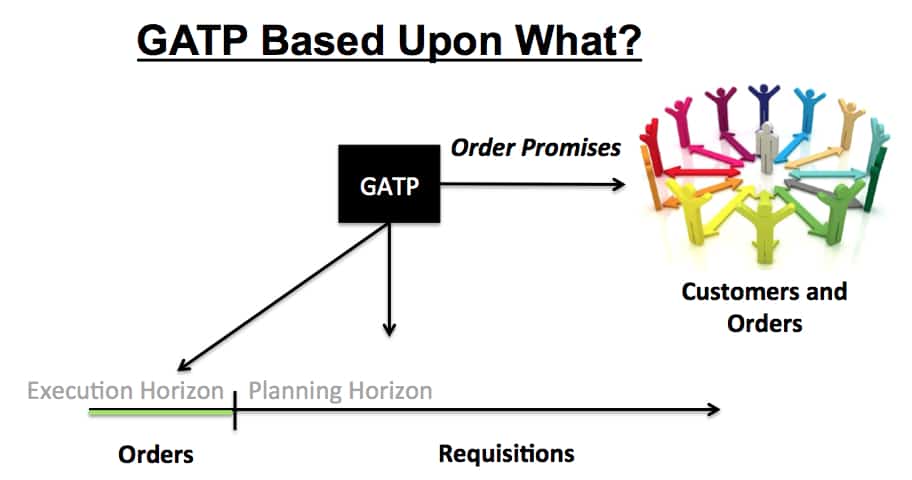How to Understand GATP and the Supply Plan Quality and the Order Promise Horizon
Executive Summary
- How does master data quality impact how GATP is run?
- What are the two basic ways that GATP can be run?
- Why is it important to ascertain the supply planning accuracy at different intervals of the supply planning horizon and important to publish the forecasting accuracy to customers who will receive sales order confirmations?
- What are the implications for order promising in a time horizon in which the supply planning accuracy is low?

Introduction to GATP
GATP is an enhanced functionality of what exists in SAP SD. The naming of GATP that is Global Available to Promise implies that the availability checking is performed on a global / i.e., geographically global scale. However, this is rarely the case as demands are satisfied by supplies that flow through regional supply chains. However, GATP provides much more scope of check than does SAP SD, so possibly a better term for GATP would be enhanced-ATP. GATP has the ability to look out to many different locations as well as forward and backward in time to provide back a confirmation on a sales order. GATP allows sales orders to consume its allocations. This is called the Checking Horizon” and is a setting in the ATP tab of the Product Location Master in APO.

Master Data Quality and GATP
GATP is an availability checking system that is completely dependent upon the supply chain plan’s quality and accuracy. However, while many executives want the capabilities provided in GATP, not every company has the plan quality to make GATP a worthwhile implementation.
In a previous article, I described the issues related to how ERP systems need to be run to enable the implementation of advanced planning systems. SAP placed GATP in APO, even though order promising is not planning. However, GATP does interact strongly with the output of a planning system, and GATP has been provided with the functionality to kick off planned orders to meet a future sales order. However, it is unclear to me whether it makes sense to use GATP in this way. But back to the main point, GATP requires planning accuracy to add value, at least it is to be used as designed. This, however, brings the two options for using GATP. These are the following:
- Using GATP to only promise back on orders
- Using GATP to promise on both order and planned orders (including, of course, stock transport requisitions)
GATP for Actuals Stock and Orders or Planned Stock and Planned Orders?
GATP is designed to perform confirmations back on sales orders into the future, and that is for planned future stock. In some cases, this planned stock is generated by SNP based upon forecasts, and in some cases, based upon reorder points. One might ask the question,
“How can future or planned stock be based upon reorder points if reorder points only kick off orders when actual stock drops below the reorder point level?”
This is actually an excellent question, and the answer is that the reorder points in SNP do not work off of only actual stock but also off of planned stock or “project stock on hand.” How this works is described in this article.
Plan Quality and How to Configure GATP to Work
GATP is designed to work off of “projected stock on hand,” which is the supply plan’s output. However, as no supply plan is 100% accurate, does this not mean that some customers will receive a confirmation and not receive their promised stock?
The answer is yes.
Does it also mean that some customers that actually could have been satisfied will be turned away, possibly months before their orders are required, and these customers will go to competitors? Yes, running GATP off of projected stock on hand means this as well. However, the concept of GATP is that there is a value added by being able to look out and provide confirmations on sales orders based upon the supply plan, then telling customers that the company cannot confirm or deny the sales order because they lack visibility out that far. The value added by GATP when used this way is, of course, dependent upon how often its confirmation is correct, which is of course only partially dependent upon GATP itself, and is more dependent upon the accuracy of the supply plan (which contains within in also the demand plan and production plan). Regardless of how GATP is setup, customers will, over time, gradually begin to take GATP generated confirmations seriously or not, depending upon how often the confirmations are correct.
Making the Determination
However, a company’s clients should not have to make this determination. Rather, the company implementing GATP should certainly determine how far out GATP should perform order promising, and this should be based upon the estimated quality of the supply plan. They should also publish this information to their customers to know the general probability of the confirmation they are receiving. Companies with a low accuracy supply plan should be discouraged from implementing GATP in that its order promising horizon is too far out vis-à-vis its actual visibility. These two options, running GATP based on orders or the basis of orders plus requisitions is included below:

Basing GATP Strictly on Orders
There is a way to run GATP for clients that have a lower than acceptable supply planning accuracy. This is to shorten the promise horizon to the point where GATP will only confirm on stock based upon orders (as opposed to requisitions). This greatly reduces the power of GATP, but for some companies that need more time to improve their supply planning accuracy, it can be the correct decision. One problem for a company that is implementing GATP along with DP, SNP, and PP/DS is what the estimated supply planning accuracy is? This is very difficult to say and depends upon many factors, not the least of which is how effective the company is currently at running more simple systems that are easier to maintain, such as SAP ERP.
Conclusion
GATP is designed to be run based upon the planned stock on hand, which is the supply plan’s output. However, the confirmations created by GATP can only be as good as what the supply planning system provides GATP. Companies must estimate this supply plan accuracy before rolling out a GATP system to its customers. It must understand what accuracy level on confirmation is generally expected and what accuracy level it can provide, as estimated along the planning horizon. This is particularly challenging with GATP is implemented simultaneously as DP, SNP, and PP/DS, as the company cannot know with a high degree of accuracy what the quality of the supply plan can be. One alternative is to shorten the order promising horizon and confirm sales orders based upon supply and production planning orders, rather than requisitions. Once the supply planning system has achieved an acceptable level of accuracy, the GATP order promising horizon can be extended.